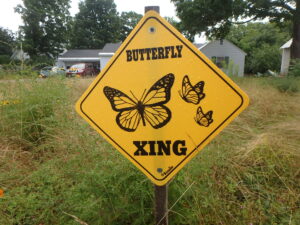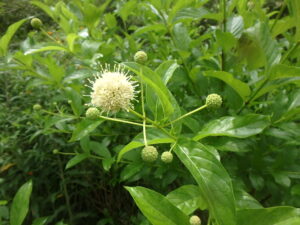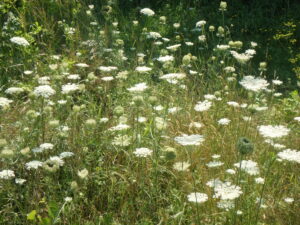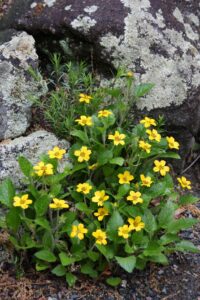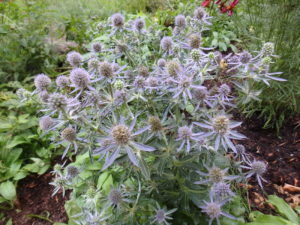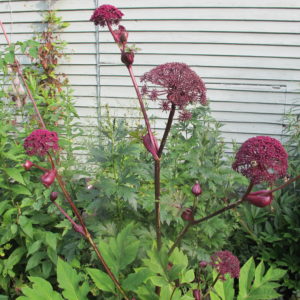Re-Wilding Your Lawn
Tired of mowing your lawn, but afraid to stop? What would it look like, and what would the neighbors say? I was on a panel discussing “re-wilding” the lawn on New Hampshire Public Radio recently. Here are a few of the points we discussed.
My advice? Start small. A little corner of the yard, say something 4 feet wide and 15 feet long would be a good start. Decide how much time you can commit to it, and how often you want to work in the garden. Can you dedicate half an hour each morning before work? An hour after work? Good gardens are built by people who do something in the garden every day.
If you want to support butterflies, birds and bees, think native plants. Native plants are those that co-evolved with the wildlife. And let wildflowers be part of the mix. Right now Queen Anne’s lace is in bloom along the roadside. It’s a biennial in the carrot family and is loved by the bees. Learn to recognize the small first year plants, dig up a few and plant them. Once established, the flowers will drop seeds each year.
Groundcovers can act a bit like mulch: they can prevent soil erosion and suppress weeds. It is often tough to find good native groundcovers like groundsel (Packera obovata) or goldenstar ( Chrysogonum virginianum) for sale, but they are available if you look hard enough. Winecup (Callirhoe involucrata) is a good groundcover for hot dry, sunny places, and is often available. Oregano and thyme can be used as an understory groundcover that bees love, and they are readily available.
Lastly, if you want a landscape that is beautiful and low maintenance, think about planting trees and shrubs. Many bloom nicely and all are useful to wildlife. Some native shrubs that I grow and love are fothergilla (Fothergilla major), blueberries, elderberry, buttonbush (Cephalanthus occidentalis) and our native rhododendron and azalea.
End of Year Reflections
This was a good gardening year for me. Although we had some rainy times, and some hot, dry times, overall the weather was conducive to good plant growth. As usual, I tried a number of new things. Here are some of the things I tried this year.
In the vegetable garden I grew a new potato variety that I liked a lot called “Magic Molly”. It is sold by Fedco Seed Coop as a fingerling, but if you let them keep growing, the potatoes get to be quite large. I love the color: a purple so deep it is almost black when picked. It is dark colored inside and out, and keeps its color quite well when cooked, so it is good looking in a stew. Some purple potatoes turn gray when cooked, which is less appealing.
I tried a new (to me) tomato this year, a hybrid from Burpee Seed Company called Brandy Boy. I met the CEO of Burpee, George Ball, at the Chelsea Flower Show in London. He told me that Brandy Boy was earlier than Brandywine, my favorite heirloom tomato, and that it had disease resistance that heirlooms don’t have. He said that the flavor was comparable to Brandywine, and I agree. Very tasty.
In order to get Brandy Boy this year I had to buy plants from Burpee – I only learned about it in late May, much too late to start plants from seed. But I’m glad I did, it gave me a chance to try it this year. Next year I will plant seeds indoors in April, which is much more economical. I checked my local nurseries for plants last May, but no one had any.
Over the years my vegetable garden has gotten shadier and shadier. Now I don’t get direct sun until mid-morning, and it gets behind trees in late afternoon. So I get about 6 hours of prime sun, with sun filtered through trees at other times. I compared notes with other growers who get bigger yields, and know that sun is a major factor. I would cut down the offending trees, but most are on my neighbors’ property. Sigh.
I planted strawberries last summer, the first time in years. Strawberries are short-lived perennial plants – three years is about all one generally gets from a planting. The first year the plants will bloom, but growers advise picking off all the blossoms so that the roots and plants will develop better. I did that, and anticipate a good crop next June.
Most strawberries are sensitive to length of day, and produce heavy crops only in June. But now there are day-neutral plants, and everbearing plants that will produce some berries all summer and into the fall. This time I chose a June-bearing variety as there is a new insect pest, the spotted-winged drosophila that is mostly present late in the season. Hopefully this fruit fly won’t arrive until my crop has finished producing.
In the flower garden I tried a new biennial, angelica (Angelica archangelica) and was delighted with it. This is a tall plant that produces globes of deep purple florets in globes about two to three inches across. Not only is it gorgeous, it attracts bees like crazy.
Like all biennials, angelica only blooms at the end of its second year of growth, then dies. I planted some of the seeds this year, but if I want it to flower next year I will have to buy another plant, and this one cost even more than a perennial flower. That leads me to believe it is not an easy flower to grow.
I was delighted to see that I finally have the proper soil for my sea holly, also called Eryngium. Sea holly has wonderful bluish flowers with spiky appendages around the globe-shaped blossoms that resemble globe thistle.
I have tried numerous times to get the proper soil to accommodate its needs, and finally got it to over winter and flower in year two. It hates good rich soil, and will only overwinter in sandy, nutrient-poor soil. So I created a spot for it by digging up some driveway soil and replacing my good soil. Bingo. It worked.
This was a great year for daylilies, which continued to bloom through much of September, even varieties that are normally finished in mid-August. I have no idea why they bloomed for such a long period, but enjoyed the show. You may not think of daylilies as cut flowers, but a scape (stem) cut with multiple buds will continue to open the buds and bloom, day after day. Just place the vase where it gets some good direct sun each day.
I planted 2 woody plants this summer: a catalpa tree and a shrub called button bush (Cephalanthus occidentalis). The catalpa will be a large specimen tree on a section of lawn that I always left for badminton. Given how little I play, I gave the lawn over to a magnificent flowering tree. It is 10 feet tall, and will get to be 40 or so, blooming in late June and into July. It’s fragrant, too.
Button bush, a native plant, likes moist soil and sun to part shade. I have plenty of moist soil, so planted one near my brook. It produces neat, round white blossoms in early summer.
I wish you all a great gardening year for 2018. May your veggies produce well, your flowers surprise you, and the Japanese beetles fly past your roses and land next door.
Henry is a UNH Master Gardener and the author of 4 gardening books. His website is www.Gardening-Guy.com. Henry blogs at www.dailyuv.com.



